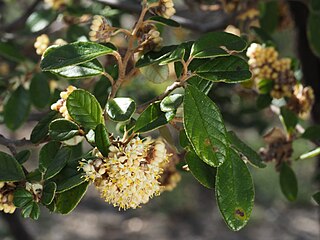
Pomaderris is a genus of about 80 species of flowering plants in the family Rhamnaceae, the species native to Australia and/or New Zealand. Plants in the genus Pomaderris are usually shrubs, sometimes small trees with simple leaves arranged alternately along the branches and bisexual, woolly-hairy flowers arranged in racemes or panicles. The flowers are usually yellow and often lack petals.

Spyridium parvifolium, commonly known dusty miller, is a flowering plant in the family Rhamnaceae. It has dark green leaves and clusters of small, whitish flowers at the end of branches. It is widespread in eastern states of Australia.

Pomaderris aspera, commonly known as hazel pomaderris, is a species of flowering plant in the family Rhamnaceae and is endemic to south-eastern Australia. It is a shrub or small tree with elliptic to lance-shaped or egg-shaped leaves and greenish-yellow flowers.

Grevillea bemboka is a species of flowering plant in the family Proteaceae and is endemic to a restricted area of far south-eastern New South Wales. It is a spreading to erect shrub with hairy branchlets, egg-shaped to elliptic leaves and red or reddish-pink flowers.

Pomaderris apetala is a small tree or large shrub from the family Rhamnaceae, growing in Victoria, New Zealand and Tasmania.
Persoonia volcanica is a species of flowering plant in the family Proteaceae and is endemic to eastern Australia. It is an erect shrub with hairy young branchlets, egg-shaped to oblong leaves, and yellow flowers borne in groups of up to twenty on a rachis up to 180 mm (7.1 in) that usually continues to grow after flowering, each flower with a leaf at its base.

Grevillea anethifolia, commonly known as spiny cream spider flower, is a species of flowering plant in the family Proteaceae and is endemic to continental Australia. It is an erect shrub with hairy branchlets, lobed leaves, the lobes sharply pointed, and white to pale yellow or cream-coloured flowers.
Petrophile stricta is a species of flowering plant in the family Proteaceae and is endemic to the south-west of Western Australia. It is an erect, spreading shrub with needle-shaped, sharply-pointed leaves, and oval heads of hairy, pink to cream-coloured flowers.
Philotheca obovatifolia, commonly known as mountain wax-flower, is a species of flowering plant in the family Rutaceae and is endemic to eastern Australia. It is a small shrub with broadly egg-shaped leaves with the narrower end toward the base and densely crowded near the ends of the glandular-warty branchlets, and cream-coloured flowers tinged with pink and arranged singly or in groups of up to five in leaf axils.

Pomaderris mediora is a rare plant from near Sydney and Wollongong, Australia. Reliably recorded from only a few sites, including the type locality of the headland north of Turimetta Beach. Described as "critically endangered" in the Illawarra with the largest population of three or four plants.

Pomaderris adnata is a spreading shrub in the family Rhamnaceae, it is endemic to New South Wales. It has smooth, elliptic or oblanceolate green leaves and pale yellow flowers in spring.
Cassinia rugata, commonly known as wrinkled dollybush, or wrinkled cassinia, is a species of flowering plant in the family Asteraceae and is endemic to south-eastern Australia. It is a spreading to erect shrub with hairy, slightly sticky branchlets, oblong to narrow elliptic leaves and corymbs of up to three hundred flower heads.

Pultenaea dargilensis is a species of flowering plant in the family Fabaceae and is endemic to a small area in central Victoria, Australia. It is a leaning or low-lying shrub with narrow elliptic to lance-shaped leaves and yellow flowers usually arranged singly on the ends of branchlets.

Hibbertia kaputarensis is a species of flowering plant in the family Dilleniaceae and is endemic to the Mount Kaputar area of New South Wales. It is a shrub with low-lying branches, oblong to lance-shaped leaves and yellow flowers with forty to about one hundred stamens arranged around three carpels.

Pomaderris andromedifolia is a species of flowering plant in the family Rhamnaceae and is endemic to south-eastern continental Australia. It is a shrub with lance-shaped to elliptic leaves and cream-coloured to yellow flowers.

Pomaderris angustifolia is a species of flowering plant in the family Rhamnaceae and is endemic to south-eastern continental Australia. It is a shrub with linear to narrowly oblong leaves and cream-coloured or yellow flowers.

Pomaderris argyrophylla, commonly known as silver pomaderris, is a species of flowering plant in the family Rhamnaceae and is endemic to north-eastern Australia. It is a shrub or small tree with lance-shaped leaves and white to cream-coloured or yellow flowers.

Pomaderris aurea is a species of flowering plant in the family Rhamnaceae and is endemic to Victoria, Australia. It is a shrub with hairy branchlets, egg-shaped or elliptic leaves and panicles of golden yellow flowers.
Hovea corrickiae, is a species of flowering plant in the family Fabaceae and is endemic to south-eastern Australia. It is a shrub or slender tree with densely hairy branchlets, narrowly egg-shaped or elliptic, dark green leaves with stipules at the base, and mostly pale to deep mauve, pea-like flowers.

Pomaderris betulina, commonly known as birch pomaderris, is a species of flowering plant in the family Rhamnaceae and is endemic to south-eastern continental Australia. It is a shrub with hairy young stems, lance-shaped to oblong or elliptic leaves, and yellowish flowers.
















